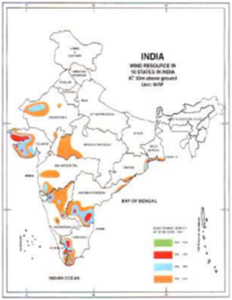Ethics Theory, TLP-UPSC Mains Answer Writing
Q. 5. “India has considerable wind energy potential, yet its development remains regionally skewed.” Examine the factors responsible for this uneven distribution and suggest measures to ensure balanced growth of wind energy across the country. (250 words, 15 marks)
Introduction
India has an estimated wind energy potential of over 1,000 GW at 120 metres hub height (as per NIWE), yet a large share of installed capacity is concentrated in just a few states like Tamil Nadu, Gujarat, Maharashtra, and Karnataka. This uneven development hinders national energy equity and sustainability.
Body
Factors Responsible for Uneven Distribution
- Wind Speed Variation: High and consistent wind speeds (greater than 6 m/s) are available mostly along the western and southern coasts. Example: Tamil Nadu and Gujarat enjoy average speeds above 7 m/s, making them more attractive for investment.
- Infrastructure and Grid Availability: Developed states have better transmission networks and grid integration facilities, encouraging more projects. Example: ISTS connectivity is more robust in Gujarat than in eastern states.
- Land Availability and Policy Support: States with clear land acquisition policies and single-window clearance systems have attracted more developers. Example: Rajasthan and Tamil Nadu have state wind policies and dedicated energy departments.
- Private Sector Interest and Investment Climate: Better ease of doing business and financing options in certain states drive regional focus. Example: Southern and western states see higher PPP engagement and FDI inflow in wind energy.
- Lack of Awareness and Technical Capacity in Other States: Several states with wind potential lack trained personnel and investor awareness, delaying project initiation.

Measures for Balanced Growth
- High-resolution Wind Mapping and Resource Assessment: Expand detailed wind resource surveys in under-explored states like Odisha, Bihar, and Assam to identify feasible zones.
- Strengthening Transmission Infrastructure: Invest in green energy corridors in underserved regions to integrate future wind projects into the national grid.
- Uniform Policy Framework and Incentives: Harmonise state-level policies and offer central incentives (like Viability Gap Funding or accelerated depreciation) to attract developers to less-utilized regions.
- Promote Offshore and Hybrid Projects: Develop offshore wind potential (e.g. along Gujarat and Tamil Nadu coasts) and promote wind-solar hybrids in lower-wind regions with higher solar irradiance.
- Community Engagement and Skill Development: Involve local communities in land leasing models and build local capacity for maintenance and operation.
Conclusion
Balanced growth of wind energy across India is crucial for energy security and environmental goals. As recommended by NITI Aayog, coordinated efforts in infrastructure, policy, and regional capacity-building can unlock the sector’s potential and ensure inclusive renewable energy development.













